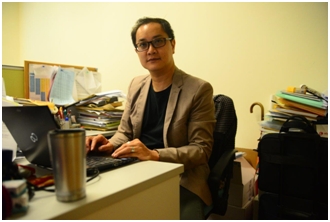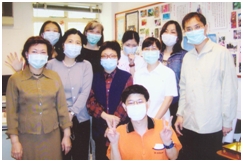PEOPLE |
|
Dr. LEE, Siu Lun
Senior Lecturer (Cantonese), Chinese Students Division, University Programme Section
Ex-officio member, Academic Activities Division |
 |
When did you being
connected to CUHK and Cantonese Education?
My relationship with CUHK started after I graduated from HKU and entered the graduate school of CUHK. At that time, I started working as a tutor teaching CUHK undergraduates linguistics (including Cantonese linguistics) and applied linguistics, as well as doing linguistic and sociolinguistic research. In early 90s in Hong Kong, there were very few tutors and teachers in the linguistic field. As a result, there were lots of interactions with students and made my teaching enjoyable. I continued with work relating to linguistics and language teaching after completed my M.Phil. I started teaching staff courses while I was working in Baptist University and understood the meanings of teaching the Cantonese language and culture to students who were interested in the language. I think teaching Cantonese language and its culture is both meaningful and interesting, then I devoted my teaching and research in the Cantonese language and its culture, especially focusing on Hong Kong culture.
Some said Cantonese
has 6 tones and some said 9 tones. What is the truth?
Introduce the
historical development stages of Cantonese as a second language.
In the literature, systematic teaching of Cantonese as
a foreign language started in the 19th century.
At that time In Hong Kong, officials of the colonial government
learnt the language. After the economic blooms in Hong Kong since 80s, Hong
Kong pop culture started to grow and Hong Kong pop songs affected other
Chinese speaking areas. Hong Kong films also became world famous. Learners
of Cantonese at that period were trying to learn the language in order to
understand “Hong Kong culture”.
In the 90s, Hong Kong issues became an international focus because of its
political and economic peculiarity during the handover period around 1997.
This attracted people who were interested in or working at Hong Kong issues
to learn the language. In
different periods in the history, learners of Cantonese had different
reasons and motivations. Our
world is always changing.
Professional teachers of the Cantonese language should continue to improve
and equip themselves in order to cope with the rapid-changing world and
future challenges. In recent
years, I also work hard to help and train professional teachers of
Cantonese, hoping that I can contribute to the field in this respect.
Many thought that
Cantonese can be automatically acquired along with the continuous stay in
Hong Kong. Cantonese Romanization is not a must. What is your opinion?
I think this question is asking about the
possibilities of self-learning.
One cannot deny that most skills (including language skills) are possible to
be self-learnt. However, there
are certain external factors and experience that suffice for self-learning,
but not all language learners have a chance to come across these experience
and external factors. When people learn some skills; appropriate learning
environment, sufficient motivation for learning, suitable learning tools and
ample practices are necessary conditions for effective learning.
Furthermore, the foreign services departments in the United States of
America and in Britain considered Cantonese as a relatively difficult
language in the world (just ranked lower than Arabic).
With all these facts, most learners preferred to learn systematically
and step-by-step with sufficient guidance.
Your question is similar to questions like, “do I need to learn to do
sports/play in ball games?” This
reminds me when I learnt how to play tennis. Some people just picked up a
racket, hit the tennis ball randomly and shouted out loudly that there was
no need to learn. On the other
hand, there were people who followed some coaches or joined some training
courses and practiced step-by-step.
I think if a person want to have good tennis skills, it is always
advantageous to have coaches; at least the forms are correct which reduce
the possibilities of injury.
Learning Cantonese (or other languages) are the same.
A systematic language programme encompasses valuable experience and
research results from teaching professionals. Together with reasonable
curricula and suitable teaching materials, a systematic programme can
increase learning effectiveness and help learners to achieve their learning
outcomes.
What are the differences in
teaching and learning between
non-local Chinese and foreign learners in learning Cantonese?
There are of course many differences between
expatriates and Mainland students learning Cantonese.
Their mother languages, cultural backgrounds, learning motivations
and learning habits are all different.
I have discussed some of the similarities and differences in my
academic writings. In fact, both
expatriate learners and Mainland students give me lots of fruitful memories.
The saying, “Speak more and listen more when one is learning a
language”, has been reiterated for decades. However, this is very useful for
all language students.
Being a pioneer of
eLearning in CLC, what is your opinion to the e-Learning development of the
Centre?
The research area of Computer Assisted Language
Learning is very board. It
includes linguistic theories, general learning theories, information
technology studies. I have been
editorial board member and reviewer of international journals for some years
and have a chance to read quality journal papers and research reports
concerning Computer Assisted Language Learning (CALL).
Different countries, different institutions have different
interpretation and views concerning computer assisted learning/e-learning.
There are also different reasons behind that drive the implementation
of computer assisted learning.
Different reasons create different targets and thus affect the e-learning
designs. I think the fact that
human beings use language to communication with each other is the foremost
important function of language. Language education can or of course should
make good use of the edge-cutting technology to assist teaching and
learning; however computer assisted learning should consider the teaching
and learning targets set forth as well as available resources of the
institution. The most important
aim of computer assisted language learning is to help learners to learn the
language effectively and to communicate using the target language with
available technology, but it is not used to train students sitting in front
of computers or watching their smart-phones spending more time with “virtual
friends” than with their friends in real life.
What is your plan in
academic development for the upcoming 1 to 2 years?
I am writing a set of teaching materials for Teaching
Cantonese as a Second Language for the Cantonese programme of the Centre.
The teaching materials will be published.
This set of materials is different from previous textbooks in the
sense that the major focus is on pragmatic language use.
The concept of language for pragmatic use can help learners to use
Cantonese actively in various real life situations.
As for research, I am working on issues in Cantonese Applied
Linguistics as well as in Language and Culture research.
Serviced in CLC for
20 years, any unforgettable stories?
The
most memorable period is the time working during the SARS period (2003) in
Hong Kong. SARS (Severe Acute
Respiratory Syndrome) was one of the major crises for Hong Kong.
Fortunately, we still had students who insisted to stay in Hong Kong;
waiting for re-start of schools and continued their studies.
At that time, all teachers needed to take care of students’
psychological stress and be aware of crisis management apart from the
ordinary teaching and administration work.
It was a difficult period. However when I saw students’ enthusiasm
and their love to Hong Kong, the teaching and administration work as a
teacher and administrator became extraordinarily meaningful.
Every
student has given me good memories.
Every student has his/her own stories, experience and reasons for
learning the language. One thing
that is the same is that they are passionate about the Cantonese language,
devoted to Cantonese culture and in love with Hong Kong. This has generated
lots of energy and support to me who is working hard to pass on the cultural
heritage of the Cantonese language and culture.
Any more advice to
Cantonese learners?
I
have mentioned, “Speak more and listen more when one is learning a
language”. It is always true.
However, how to “speak more and listen more” needs teachers and
students to work together.
Teachers should guide students to tackle various difficulties and problems
when learning the language. Students should try to find learning and
training styles that are suitable to themselves.
It is relatively easy to talk about these theories; however it
requires continuous efforts of both teachers and students to put these
theories into practice.
What is your favorite
pastime?
Recently I like cooking.
It is a pity that there is no chef recommendation.
I am still learning by trials and errors.
The only wish is to learn step-by-step and get some progress.
Right! Cuisines encompass
cultural values, traditions and habits of different countries and regions.
Oh no! we are coming back to issues concerning culture and language.
Anyway, let’s remember healthy-eating is one of the many good aspects
about cooking.
 |
About Us
| Contact Us
| Privacy
|
Disclaimer
Copyright © 2016.
All Rights Reserved. The Chinese University of Hong Kong.
